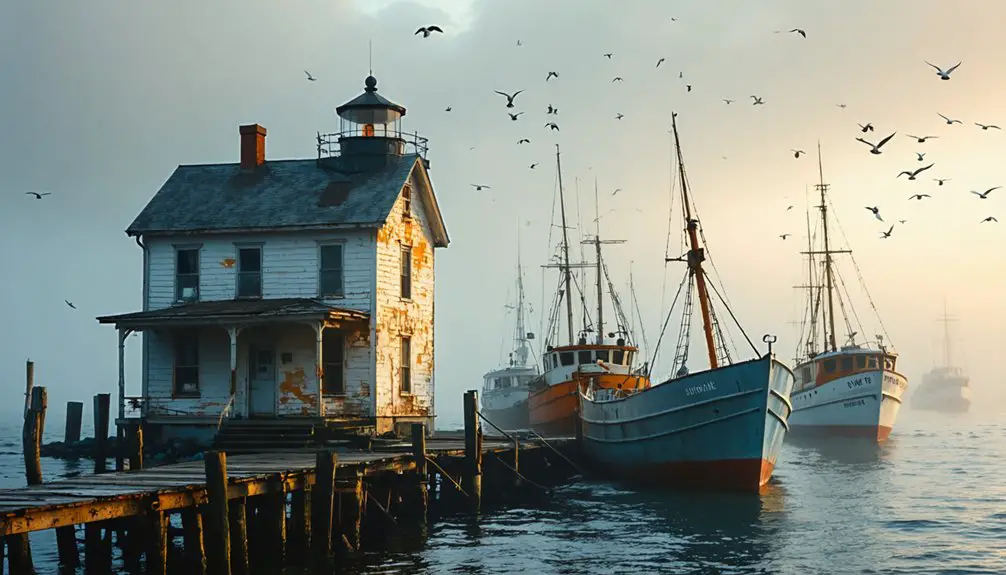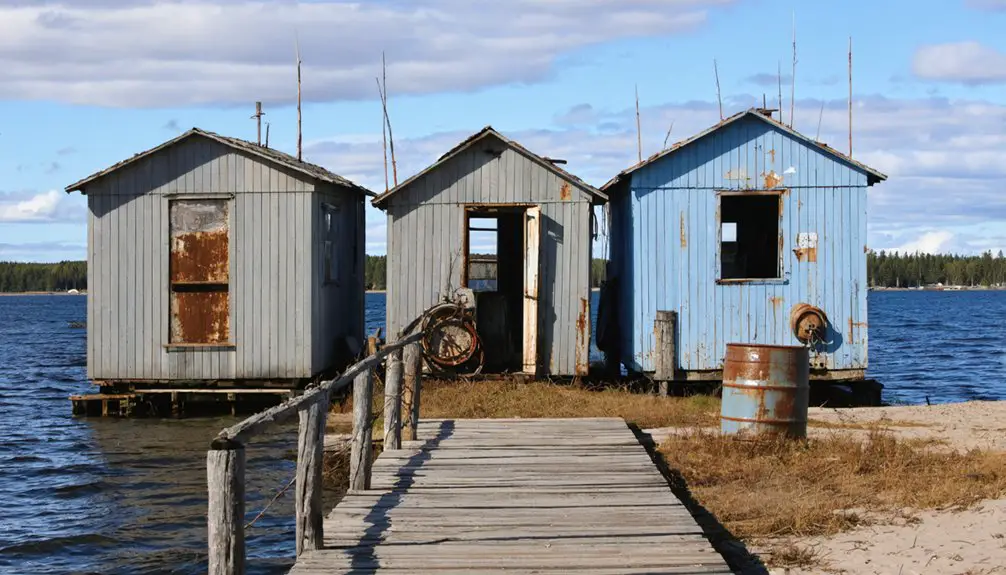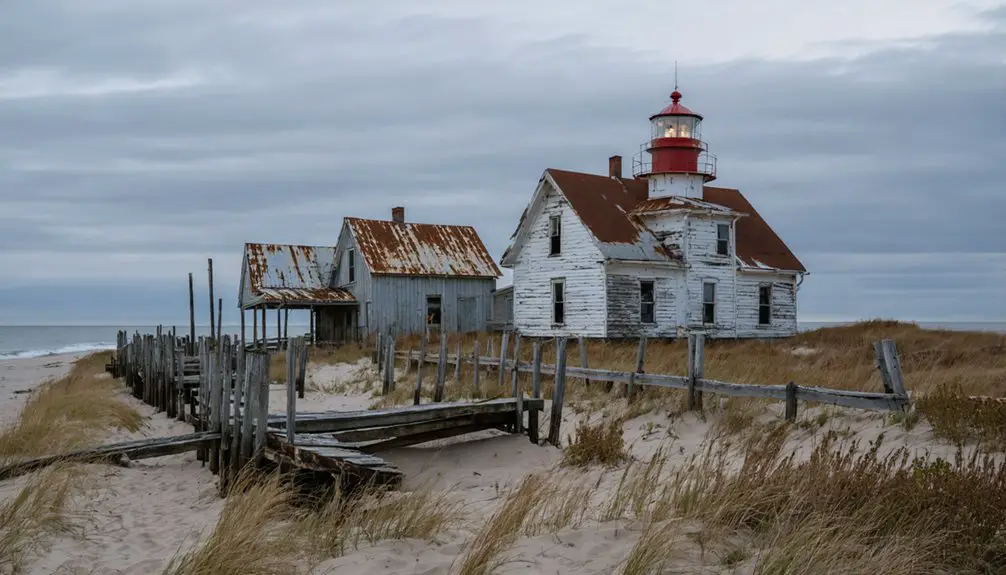You’ll find Shelldrake Village, an abandoned lumber boomtown, near Whitefish Point in Michigan’s Upper Peninsula. Established in 1895 by the Penoyer Brothers, this once-thriving community boasted modern amenities like hot water, indoor bathrooms, a hospital, and a massive icehouse capable of feeding 1,000 residents. Now privately owned, the ghost town stands as a silent witness to Michigan’s lumber industry heyday, with its rich maritime heritage waiting to be discovered.
Key Takeaways
- Shelldrake Village, near Whitefish Point, transformed from a Native American fishing settlement into a prosperous lumber boomtown in 1895.
- The town featured modern amenities including hot water, bathrooms, a hospital, schoolhouse, and post office during its peak.
- Daily stagecoach service and passenger ships connected the bustling community of 1,000 residents to surrounding areas.
- The town’s success relied on sawmill operations and strategic location with docks and tramways for lumber transport.
- Today, Shelldrake exists as a privately owned ghost town, preserving remnants of Michigan’s historic lumber industry.
The Rise and Fall of Shelldrake Village
Before its rise as a lumber boomtown in the late 1890s, Shelldrake was a seasonal Native American fishing village nestled along Michigan’s Whitefish Point.
The area’s Shelldrake history took a dramatic turn when Lewis Cass explored it in 1820, though European settlement wouldn’t begin for decades.
In 1895, the Penoyer Brothers from Bay City transformed Shelldrake into a thriving lumber town.
You’d have found a modern community with hot water, bathrooms, and amenities like a hospital, schoolhouse, and post office.
The town’s success relied on its sawmill operations and strategic location, with docks and tramways moving timber into Lake Superior.
A massive icehouse facility could store enough meat to feed a thousand residents through the winter months.
Today, as a privately owned ghost town, Shelldrake offers a haunting glimpse into Michigan’s lumber industry past.
Maritime Heritage at Whitefish Point
As you stand at Whitefish Point Light Station, you’re witnessing one of Lake Superior’s most historically significant maritime beacons, guiding vessels since 1849 through the treacherous waters known as Shipwreck Coast.
The oldest operating lighthouse on Lake Superior continues to serve as a vital navigational aid to this day.
You’ll find nearly 200 shipwrecks in the surrounding waters, including the legendary Edmund Fitzgerald, which sank just 15 miles northwest of the point in 1975 with all 29 crew members lost.
Visitors can explore the Lighthouse Keeper’s Quarters through self-guided tours of the historic site.
Local lore tells of the Grace tugboat’s phantom captain, who still patrols these waters, marking just one of the many maritime mysteries that have earned Whitefish Bay its haunting nickname, “Graveyard of Ships.”
Lighthouse Guides Ships Home
The Whitefish Point Lighthouse stands as Michigan’s oldest operating beacon on Lake Superior, faithfully guiding mariners since 1849 through one of the Great Lakes’ most treacherous passages.
You’ll find this crucial maritime navigation aid at the southeastern tip of Lake Superior, where its iron skeletal tower has withstood fierce storms since 1861.
The lighthouse’s technology evolved from whale oil lamps to a powerful Fresnel lens that could project light 25 miles across the water.
Today’s modern DCB-224 aero beacon reaches even further, casting its beam 26 nautical miles with distinctive flashes every 20 seconds.
For generations, keepers maintained this critical beacon, rescued shipwreck survivors, and assisted vessels in distress until automation in 1970.
President James K. Polk originally purchased 115.5 acres of land to establish this vital maritime facility.
Even now, it continues its essential role in safeguarding ships through the dangerous Shipwreck Coast. The area has earned the nickname Graveyard of the Great Lakes due to the numerous vessels lost in its perilous waters.
Shipwreck Coast’s Dark Legacy
Stretching along Lake Superior’s southern shore for 80 treacherous miles, Shipwreck Coast has earned its ominous name through centuries of maritime disasters.
As you explore Whitefish Point, you’ll discover that nearly 200 of Lake Superior’s 550 major shipwrecks lie in these waters, each vessel falling victim to the region’s unpredictable storms and treacherous navigation hazards. The discovery of the first all-steel vessel Western Reserve in 2024 added another chapter to these historic waters.
You’ll find shipwreck stories etched into every corner of Whitefish Bay, aptly nicknamed the “Graveyard of Ships.” Since 1848, the navigational light has stood guard, helping mariners navigate these perilous waters.
The most famous tale belongs to the Edmund Fitzgerald, which sank in 1975 with all 29 crew members.
While maritime myths abound, the Great Lakes Shipwreck Museum preserves the true legacy of these waters, displaying authentic artifacts including the Fitzgerald’s recovered bell – stark reminders of the point’s dark but fascinating maritime heritage.
Grace Tugboat’s Ghostly Captain
Among Lake Superior’s most enduring ghost stories, you’ll find the tale of the Grace tugboat captain who met a poignant end in 1879 near Whitefish Point.
After his vessel broke down during a fierce storm, the captain successfully guided his crew to safety across 200 feet of treacherous water when they struck a sandbar near Shelldrake.
Upon reaching shore, he uttered, “Thank God, we’re all safe” before suffering a fatal heart attack.
Today, maritime legends speak of ghostly sightings near the Shelldrake docks, where witnesses report seeing a caped figure with a pipe emerging from the lakeside. This area’s treacherous waters have claimed over 200 known shipwrecks near Whitefish Point alone.
The original lighthouse, established in 1849, stood as a vital beacon to help prevent such maritime tragedies.
When boats approach, the apparition vanishes – a haunting reminder of the captain’s sacrifice and the dangerous waters that claimed so many vessels along this stretch of coast.
Life in a Thriving Lumber Town
During its peak around the turn of the 20th century, life in Whitefish Point and nearby Shelldrake reflected the prosperity of Michigan’s booming lumber industry.
Before becoming a ghost town, Shelldrake offered workers a surprisingly modern lifestyle with amenities you’d expect in more established cities:
- Comfortable housing with plastered walls, hot water, and indoor bathrooms
- A robust infrastructure including a hospital, school, and post office
- An impressive icehouse that could feed 1,000 residents through winter
You’d find daily stagecoach service to Eckerman in summer and passenger ships to Sault Ste. Marie, keeping you connected to the wider world.
Beyond lumber, you could’ve joined the thriving cranberry trade, with over a dozen local growers contributing to the area’s diverse economy.
The Legendary Ghost Captain’s Tale

While the bustling lumber town once drew workers with its modern amenities, a more mysterious resident now calls Shelldrake home.
You’ll hear tales of a ghostly captain who appears on the old dock, pipe in mouth and cape billowing, only to vanish as boats draw near. This spectral legend traces back to a tragic October day in 1879, when the tugboat Grace wrecked near shore. Though the crew survived, their captain suffered a fatal heart attack moments after expressing relief for their safety.
Today, ghostly sightings persist around Shelldrake’s abandoned buildings, where lights mysteriously illuminate empty rooms and shadowy figures drift past windows.
While the private property status keeps most visitors at bay, the captain’s spirit remains a steadfast guardian of this Lake Superior shore.
Preserving Michigan’s Historic Lighthouse
You’ll find the Whitefish Point Lighthouse still standing proud after more than 170 years of guiding vessels through Lake Superior’s treacherous Shipwreck Coast, where over 200 vessels met their fate.
The lighthouse’s preservation efforts include a $40,000 grant from the Michigan Lighthouse Assistance Program, which helps maintain the original 1861 design features like the lantern room’s clear glass and the 80-foot tower that broadcasts its beam 25 miles across the water.
While the lighthouse no longer relies on whale oil or requires dedicated keepers to maintain its signal, its ongoing restoration guarantees that this vital piece of maritime safety history will continue to serve both as a functional beacon and as a window into Michigan’s rich nautical past.
Maritime Safety Legacy
Three pivotal decades after Congress established Whitefish Point Light in 1849, this beacon became the cornerstone of maritime safety along Lake Superior’s treacherous Shipwreck Coast.
You’ll find over 200 shipwrecks in these dangerous waters, where the lighthouse’s third-order Fresnel lens once guided countless vessels to safety.
The lighthouse’s critical role in maritime safety expanded through:
- A Coast Guard Lifeboat Rescue Station operating from 1923 to 1951
- Advanced navigational technology, evolving from manual operation to LED systems
- Weather monitoring and fog horn systems protecting ships from disaster
Though automated since 1971, Whitefish Point Light continues its vigilant watch.
The Great Lakes Shipwreck Museum now preserves this legacy, including artifacts from vessels like the Edmund Fitzgerald, reminding you of the eternal battle between mariners and Superior’s fierce waters.
Historical Restoration Efforts
Since its initial construction in 1861, Whitefish Point Light has undergone extensive restoration efforts to preserve its historical integrity.
You’ll find that the lighthouse preservation project received significant support through a $40,000 Michigan Lighthouse Assistance Program grant, complemented by private donations including $24,000 in paint from Sherwin-Williams.
The historical restoration has focused on key structural elements, replacing aged materials like the original glass lantern windows that had been switched to plastic lexan by the Coast Guard.
Future phases, estimated to exceed $100,000, will target the iron-pile skeletal structure and spiral staircase. While modern upgrades like LED lighting have been implemented, they’ve been balanced with historical authenticity.
The Great Lakes Shipwreck Historical Society continues to spearhead fundraising efforts for this iconic structure’s ongoing preservation.
Daily Life and Community Infrastructure

During its peak years in the late 1800s, Whitefish Point maintained a robust community infrastructure that supported its working population.
You’d find workers’ homes built with attached bathrooms clustered near the sawmill, where daily routines centered around lumber production. Community gatherings often took place at shared facilities, while the icehouse stored enough meat to feed 1,000 people through winter.
- A fully-equipped hospital provided crucial medical care for residents.
- The schoolhouse served the community’s children, ensuring education continued year-round.
- A post office maintained essential connections to the outside world through mail service.
Transportation options included daily stagecoach service to Eckerman and water routes across Lake Superior, keeping you connected to neighboring communities and crucial supplies.
Natural Resources and Local Industries
While you’d find limited industrial development in early Whitefish Point, the surrounding forests provided essential timber for shipbuilding and infrastructure maintenance at the lighthouse and Coast Guard Station.
The region’s natural landscape, primarily composed of sand and cranberry marsh, restricted large-scale agriculture but enabled successful cranberry harvesting, as noted in 1847 land reservations.
Beyond these primary resources, the area supported small-scale subsistence activities for both indigenous peoples and settlers, who relied on local natural materials for basic needs.
Lumber and Mill Operations
As French settlers established their first forts and missions in Michigan, they launched the region’s earliest logging efforts, setting the stage for Whitefish Point’s eventual emergence as an important lumber hub.
When skilled loggers from New England arrived, they brought advanced lumber techniques that transformed the local industry. You’ll find that Whitefish Point’s population swelled from 60 to 200 residents during peak operations, supporting a thriving mill-centered community.
Key features of Whitefish Point’s lumber operations included:
- Massive white pine trees reaching 200 feet tall and 5 feet in diameter
- Mill innovations like Overpack’s “Big Wheels” that boosted productivity
- River systems serving as natural highways for log transport
The local mills played a significant role in Michigan’s broader lumber boom, connecting Whitefish Point’s timber resources to markets across the Great Lakes region.
Cranberry Cultivation Success
The natural environment surrounding Whitefish Point proved perfectly suited for cranberry cultivation, with its abundant wetlands, small lakes, and Sand Creek providing ideal growing conditions.
You’d find more than a dozen growers operating during the industry’s peak years between 1888-1910, using innovative harvesting techniques like narrow-tined forks to comb vines and float berries for collection.
The cranberry economics were impressive – in 1897, Vermilion Point alone produced 1,600 bushels.
Workers controlled water flow through earthen dams, protecting vines during winter freezes. They’d load harvested berries onto flat-bottomed boats and process them using water wheels and conveyors.
The final products traveled via tramway to Lake Superior, where ships carried them to lucrative markets in Chicago and Duluth, sustaining this thriving industry for 45 years until 1932.
Transportation and Trade Routes
Located at a critical juncture of Lake Superior’s shipping lanes, Whitefish Point emerged as an essential transportation hub during the 19th century.
As you explore the area’s trade networks and transportation history, you’ll discover how this strategic location shaped regional commerce through its:
- Daily stagecoach service to Eckerman, connecting overland routes with maritime traffic
- Role as a crucial resupply point for logging companies and fishing operations, complete with general store and post office
- Position along major shipping routes for bulk carriers transporting taconite and other raw materials
You’ll find the 1861 lighthouse standing as a memorial to Whitefish Point’s maritime significance.
This beacon guided countless vessels through treacherous waters known as the “Graveyard of Ships,” where approximately 200 shipwrecks occurred, shaping the evolution of Great Lakes navigation safety.
Remains of a Lost Era
Today, scattered remnants of Whitefish Point‘s once-thriving maritime community dot the Lake Superior shoreline, offering glimpses into Michigan’s rich shipping and fishing heritage.
You’ll find weathered fishing boats, old docks, and storage buildings that spark village nostalgia, telling stories of community survival in this harsh environment.
Between the harbor and former post office site along Whitefish Point Road, you can trace the physical layout of what was once a bustling settlement.
Brown’s fishery, the last of its kind, stands as an indication of the area’s declining fishing industry.
The solitary Brown’s fishery remains a poignant reminder of what was once a thriving way of life along these waters.
While most property remains privately owned, the visible infrastructure reflects a different era – one where icehouses, maritime facilities, and basic amenities supported a determined population focused on carving out a life along Lake Superior’s untamed shores.
Lake Superior’s Shipwreck Legacy
Beyond the weathered buildings and maritime remnants of Whitefish Point lies a darker legacy beneath Lake Superior’s waves.
You’ll find approximately 550 shipwrecks scattered across these waters, with 200 concentrated along the treacherous 80-mile Shipwreck Coast. The area’s shipwreck stories reveal tales of sudden storms, nighttime collisions, and tragic losses.
- The Edmund Fitzgerald’s famous 1975 sinking claimed 29 lives just 17 miles from Whitefish Bay
- The SS Scotiadoc rests at 850 feet, marking the deepest known Great Lakes shipwreck
- The Superior City’s 1920 collision resulted in 29 deaths along this perilous stretch
Today, underwater archaeology efforts continue to uncover these time capsules of maritime history, while the Whitefish Point Light Station stands guard, as it has since becoming Lake Superior’s oldest operational lighthouse.
Frequently Asked Questions
What Happened to the Residents of Shelldrake After the Town’s Decline?
Like John Miller’s family moving to Sault Ste. Marie, you’ll find resident migration followed Shelldrake’s economic impact. Workers and their families relocated to nearby Upper Peninsula towns where they’d find new employment.
Are There Any Descendants of Original Shelldrake Families Still Living Nearby?
You won’t find documented descendant stories or family legacies of original Shelldrake residents in the area today. While some descendants might exist nearby, there aren’t any confirmed cases in public records.
What Was the Average Winter Temperature During Shelldrake’s Peak Years?
You’d find winter temperatures averaged between 9.5°F to 11.1°F for lows and 24°F to 26°F for highs, with heavy seasonal variations and significant average snowfall throughout the cold months.
Did Native American Communities Continue Living in the Area After Shelldrake’s Establishment?
Like unbending pines in winter winds, Native heritage endured. You’ll find that indigenous communities didn’t vanish but adapted, showing community resilience through seasonal fishing and resource gathering into the late 1800s.
How Much Did Lumber Workers Typically Earn at Shelldrake’s Sawmill?
You’d likely have earned $1.50-$3.00 per day working at Shelldrake’s sawmill, with pay varying by your role. Lumber industry wages depended on seasonal conditions and sawmill working conditions.
References
- https://lostinthestates.com/the-haunted-michigan-ghost-town-of-shelldrake/
- https://en.wikipedia.org/wiki/Shelldrake
- https://mikelbclassen.com/2021/05/13/whitefish-point-more-than-a-lighthouse/
- https://shipwreckmuseum.com/visit/whitefish-point-light/
- https://www.onlyinyourstate.com/experiences/michigan/trail-to-abandoned-village-mi
- https://lostinmichigan.net/tag/haunted/
- https://975now.com/shelldrakemichigan/
- https://99wfmk.com/remains-of-shelldrake-michigan-2020/
- https://tahquamenoncountry.com/things-to-do/history-and-culture/whitefish-point
- https://saultstemarie.com/archive/great-lakes-shipwreck-museum/



